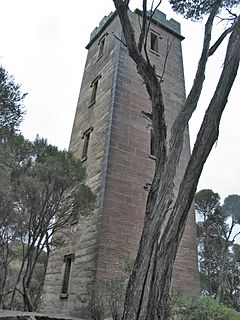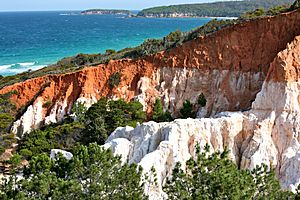Beowa National Park facts for kids
Quick facts for kids Beowa National ParkNew South Wales |
|
|---|---|
|
IUCN Category II (National Park)
|
|

Ben Boyd's tower
|
|
| Established | 1971 |
| Area | 104.86 km2 (40.5 sq mi) |
| Managing authorities | NSW National Parks & Wildlife Service |
| Website | Beowa National Park |
| See also | Protected areas of New South Wales |
Beowa National Park, once known as Ben Boyd National Park, is a special protected area in New South Wales, Australia. It is located about 578 kilometers (359 miles) south of Sydney. This park is a great place to explore unique landscapes and see amazing wildlife.
Contents
History of Beowa National Park
The park was first created in 1971. It covered about 8,900 hectares (35 square miles). It was originally named after a wealthy businessman named Benjamin Boyd.
In September 2022, the park's name was changed to Beowa. This change happened after many discussions with Aboriginal and South Sea Islander communities. The name "Beowa" is important to the local Aboriginal people. The park has since grown to cover 10,486 hectares (40 square miles).
Benjamin Boyd was a rich businessman in the 1840s. He was involved in shipping, including whaling. He also used a practice called "blackbirding." This meant bringing people, often from Melanesia, to Australia for forced labor. This practice was similar to slavery.
After worldwide protests in 2020, like the Black Lives Matter movement, people asked for the park to be renamed. The NSW Environment Minister, Matt Kean, agreed. He said national parks should bring people together, not divide them. He promised to talk with local elders and the community about a new name.
Boyd had started building a sandstone tower. This tower was meant to help whaling crews spot whales near Twofold Bay. However, the tower was never finished. In November 2021, it was announced that the park would be renamed. The new name, Beowa National Park, became official in September 2022.
What to See in Beowa National Park
The park is split into two parts, on either side of Twofold Bay and the town of Eden.
Northern Section of the Park
The smaller northern part of the park is next to the Princes Highway. The rocks here are mostly sedimentary rock, like ironstone and clay. You can also see some quartzite rocks.
A popular spot for visitors is called The Pinnacles. This is a colorful gully formed by erosion. It has bright white sand covered by rusty red clay. It's a very unique sight!
Southern Section of the Park
The southern part of the park has a coastline with metamorphic rock. Some parts, like Red Point near Boyd's tower, have very folded rock formations.
The park is mostly flat. The northern section is less than 100 meters (300 feet) high. The southern section is a bit higher. The tallest point is Haycock Hill, at 252 meters (827 feet).
The area can be windy, dry, and cold. The headlands, which are pieces of land sticking out into the sea, have low-growing plants called heathland. Further inland, you'll find open eucalypt woodlands. These woodlands make up most of the park's habitat. The main trees are silvertop ash and red bloodwood. You can also find small areas of rainforest in protected gullies. Here you might see trees like scentless rosewood.
Wildlife in Beowa National Park
Beowa National Park is home to many different animals.
Birds of the Park
Over 212 types of birds have been seen in the park. The heathlands are home to special birds like the eastern ground parrot and the endangered eastern bristlebird. The little tern builds its nests in the sand dunes and on beaches. This bird is sometimes threatened by four-wheel driving vehicles.
The park is part of an area called the Ulladulla to Merimbula Important Bird Area. This area is important for birds like the swift parrot.
Mammals and Other Animals
Fifty different kinds of mammals have been recorded in the park. You might see kangaroos, wallabies, or possums.
Sometimes, animals that are not native to the park, like cats and foxes, can cause problems. Rabbits can also be found in areas that were once cleared. A plant called Bitou bush is a problem weed in some parts of the park.
See also
 In Spanish: Parque nacional Ben Boyd para niños
In Spanish: Parque nacional Ben Boyd para niños



